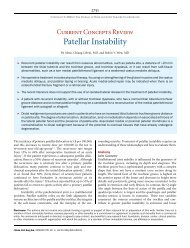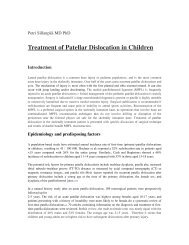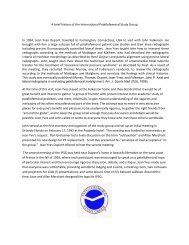Rehabilitation of the Knee After Medial Patellofemoral Ligament ...
Rehabilitation of the Knee After Medial Patellofemoral Ligament ...
Rehabilitation of the Knee After Medial Patellofemoral Ligament ...
- No tags were found...
Create successful ePaper yourself
Turn your PDF publications into a flip-book with our unique Google optimized e-Paper software.
<strong>Medial</strong> Patell<strong>of</strong>emoral <strong>Ligament</strong> Reconstruction 285ROMProlonged joint immobilization results in <strong>the</strong> loss <strong>of</strong> ground substance and dehydration<strong>of</strong> <strong>the</strong> extracellular matrix. 4,5 These changes reduce <strong>the</strong> distance between fibers within<strong>the</strong> matrix, causing friction and adhesion that reduce suppleness in periarticular ligamentsand cartilage. In contrast, mobilization <strong>of</strong> an injured joint is associated wi<strong>the</strong>nhanced collagen syn<strong>the</strong>sis and more optimal fiber realignment within <strong>the</strong> tissues,reversing <strong>the</strong> processes seen with immobilization.It is not always possible to move joints immediately after surgery, but early motion isclearly desirable. 6 Experience has shown that immediate, controlled ROM is not detrimentalto fixation or graft development in well-positioned and securely fixed ACLgrafts. Fur<strong>the</strong>rmore, early motion seems to be beneficial to <strong>the</strong> limb as a whole byreducing pain, promoting healthy development <strong>of</strong> cartilage and periarticular tissues,and preventing scar formation and capsular contractions. 7 Therefore 1 goal <strong>of</strong>MPFL reconstruction is to use a competent graft, place it so that it will not be harmedby physiologic motion, and secure it well enough to withstand <strong>the</strong> loads associatedwith normal joint motion.<strong>After</strong> MPFL reconstruction, loss <strong>of</strong> full passive extension is rarely seen. However, itcan be difficult to regain full flexion. In addition, failure to achieve full active extension(residual extensor lag) has been reported at short and long-term follow-up. 8 Thereasons for motion difficulties after MPFL reconstruction seem to be related to <strong>the</strong>dissection and MPFL graft location. Cyclops lesions, such as those that can physicallyblock knee extension after ACL reconstruction, have not been reported after MPFLreconstruction. But capsular and/or infrapatellar fat pad contracture, quadriceps inhibition,and poorly positioned grafts can lead to <strong>the</strong> complications noted earlier.An early goal <strong>of</strong> rehabilitation after MPFL reconstruction is to reestablish full kneeextension. Unlike ACL reconstruction, return <strong>of</strong> passive knee extension does not guaranteefull active extension. For that to occur, attention must focus on quadricepsstreng<strong>the</strong>ning (see later discussion for details). Pain and swelling can be mitigatedwith electrical stimulation, cold <strong>the</strong>rapy, and compression wraps. Passive patellarglides should be instituted as soon as tolerated, to reestablish normal passive patellarmobility within <strong>the</strong> trochlear groove in all directions (superiorly, inferiorly, medially, andlaterally). Many patients have considerable apprehension because <strong>of</strong> <strong>the</strong>ir prior experiencewith patellar hypermobility, and mobilization can improve confidence in <strong>the</strong>irnewly acquired patella stability.Return <strong>of</strong> passive flexion can be difficult for several reasons. If <strong>the</strong> graft is not positionedproperly it may tighten in flexion and te<strong>the</strong>r <strong>the</strong> joint. Injury around <strong>the</strong> medialepicondyle, whe<strong>the</strong>r traumatic or surgical, is also associated with persistent joint stiffnessif early attention is not given to full knee flexion in <strong>the</strong> rehabilitation program. Thegoal is to exceed 90 flexion within 6 weeks postoperatively. If that goal is achieved,<strong>the</strong>n in <strong>the</strong> authors’ experience limited knee flexion will not be a problem. On <strong>the</strong> o<strong>the</strong>rhand, delay in achieving greater than 90 <strong>of</strong> knee flexion may allow scar tissue proliferationand formation <strong>of</strong> adhesions around <strong>the</strong> graft and within <strong>the</strong> medial knee s<strong>of</strong>ttissues. Manipulation may be required to regain full knee motion if flexion past 90 is not accomplished by week 6.QUADRICEPS STRENGTHENINGSurgery <strong>of</strong> <strong>the</strong> extensor mechanism is particularly prone to cause quadriceps inhibitionand dysfunction, and every effort should be made to regain quadriceps control,strength, and endurance. If <strong>the</strong> reconstruction has been performed properly, <strong>the</strong>ncontrolled quadriceps contractions pose no threat to <strong>the</strong> graft. Quadriceps setting






